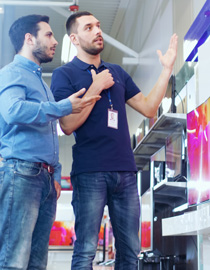Why Salespeople Lose Sales
Contrary to what many people believe, most salespeople want their customers to make good decisions. They want them satisfied, whether it’s buying shoes, home improvement, a vacation package, a car, or an insurance policy.
Even so, salespeople accidentally lose sales. They leave customers unsatisfied, not dissatisfied. Customers become dissatisfied after making a purchase; if they’re unsatisfied, they walk away before buying.
Intent on rattling off features and benefits, salespeople forget they must understand the customer’s need to buy before the facts will make sense. In doing so, they overwhelm customers.
Why do salespeople do this? They want customers to make informed buying decisions. But this is the fallacy. It’s not until after the sale that the rational stuff makes sense to customers. What must come first is the inner motivation for saying yes.
A Salesperson’s Most Important Task
Here’s the point: it’s the wow that grabs attention and excites customers. The salesperson’s task is figuring out what it is that motivates a customer. Once that button is pushed, the facts serve to justify the purchase.
Here are 10 motivations that move customers to buy:
- To enhance their status — There are certain things we want to buy because they tell a story — buying a home or designer sunglasses, taking an exotic vacation, dining at certain restaurants, having an expensive vehicle, wearing certain clothing, or even having a certain hair style. “The beautiful objects that we prize are really signs to others that they should prize us,” writes Matthew Willcox in The Business of Choice.
- To make a dream come true — We’re surprised when someone makes a purchase that’s “out of character,” as the saying goes. When asked about it, the person responds, “You know, I’ve always wanted it and I’ve been saving for years. It’s a dream come true.”
- To make amends — We may view ourselves as independent and free from past influences, but our purchases may tell a different story. A woman had a rocky relationship with her mother, but the first car she bought was the brand her mother always wanted.
- To be defiant — Someone says, “That’s not a good idea. Is that something you really need?” or “You can’t afford that.” Such words become challenges, powerful forces driving us to “show them,” while pointing out how easy it is for adults to demonstrate adolescent behavior.
- To feel good — There’s more than one type of self-medication. Close to the top of the list may be buying stuff to make us feel better. A cup of hot cocoa on a cold winter night, a plate of Mac and Cheese, a latte, and, of course, fries. But, like other types of self-medication, the effects wear off and it’s time to do it again.
- To feel safe — Some things go beyond just feeling good; we also want to feel safe. The old idea that “your home is your castle,” a place with thick walls and a moat, is as current today as it was centuries ago. This may be a reason why tourists flock to visit them. We buy everything from dead bolts to security systems to insurance policies and organizational memberships to help us feel safe.
- To forget our problems — Whether it’s buying clothes to help us “look the part” or taking an exotic vacation to get “recharged,” purchasing our way out of problems is nothing new. During The Great Depression, Americans went to the movies to forget their misery and in the ’40s to take their minds off the horrors of war. Today, we binge on Netflix and hit the Amazon buy button.
- To make a statement — Why do so many former jocks, who are now sportscasters, don three-piece bespoke suits, while CEOs and salespeople shed theirs for open collar shirts? It almost looks as if they’re trying to trade places. Helping immigrants lose an accent is a growing business. And then there’s the big and powerful pick-up truck with its own message. Much of what we buy is to make a statement.
- To feel we’re somebody — Kit Yarrow, Ph.D., the author of Decoding the New Consumer Mind, describes the big change that’s occurred in how we shop and our reasons for buying. “Most notable is an increased emphasis on the fundamental need to be seen, respected, and connected,” says Yarrow.
- To reward ourselves — While it’s obvious that Starbucks sells coffee, that’s misleading. What they sell are low-cost rewards. It’s easy to drop $4 plus for a latte and not much less for a Tall coffee. But the cost is small compared to shoes, jeans, a getaway vacation, a dinner out, or some other splurge. We reward ourselves to fit our finances, but never get around to adding it all up. One report indicates that the average person spends over $700 a year on coffee alone.
Customers respond positively when they believe salespeople understand them. When this doesn’t occur, they’re unsatisfied and they leave. Something is missing and piling on reasons for saying yes is useless. Information overload only makes it worse. Once an emotional need is met, the facts make sense and the sale closes.
MANA welcomes your comments on this article. Write to us at [email protected].


